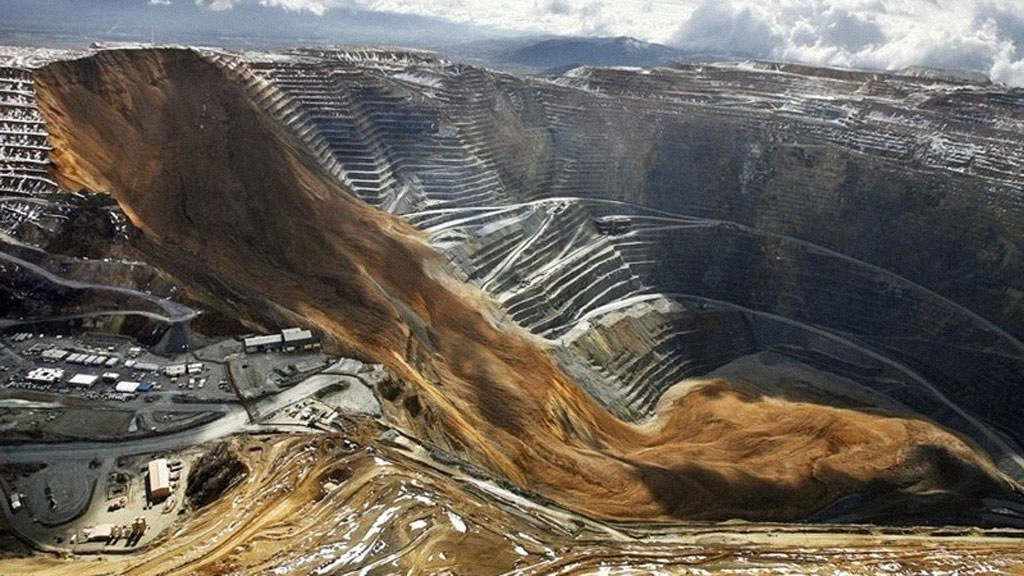(after the initial knee-jerk the price actually went down)
This week we look at the slide itself.

From Boing-Boing
Inside a mile-deep open-pit copper mine after a catastrophic landslide
For the past few months I’ve been reporting a big story on the copper industry for Pacific Standard. It takes a broad look at how the global economic boom of the past decade, led by China and India, is pushing copper mining into new regions and new enormities of investment and excavation. (It’ll be out in June.) But a few days ago a very local event shook the copper industry, and I thought it would be neat to look at how a crisis at a single mine can ripple through space and time, ultimately affecting just about everyone around the globe.
Above is a picture, from local news channel KSL, of a massive landslide at Bingham Canyon Mine, about 20 miles southwest of Salt Lake City.
Bingham is an open-pit mine—a gigantic hole in the ground. The landslide, in effect, was the collapse of one of the pit walls. (For scale, the pit is a bit less than three miles wide and a bit more than three-quarters of a mile deep, and as you can see, the collapse stretches halfway across it and all the way from top to bottom.) Kennecott Utah Copper, the subsidiary of the mining giant Rio Tinto which runs Bingham Canyon, has a spectacular Flickr set here. Check ’em out.
The landslide went off at about 9:30 in the evening on Wednesday, April 11. It was expected: like most modern mines, Bingham has redundant sensor systems (radar, laser, seismic, GPS) that measure ground movement down to the millimeter and give plenty of warning when a collapse is imminent. The mine was evacuated about 12 hours before the landslide, and nobody was hurt.
But the scale of the landslide was a surprise. Approximately 165 million tons of rock shifted, causing a highly localized earthquake measuring 5.1 Richter. It damaged or destroyed roads, power lines, and other infrastructure, and a number of the giant shovels and dump trucks that move ore and waste rock out of the pit. (For gearheads, the shovels are P&H 4100s and the trucks are Komatsu 930Es. Bingham’s fleet includes 13 of the former and 100 or so of the latter. Here’s a fun picture showing the scale of a 4100’s scoop)
The lost equipment was worth tens of millions of dollars, but much more significant is the fact that the landslide has shut Bingham Canyon down for an as-yet undetermined length of time. Much more significant because Bingham Canyon is not just another copper mine. Physically, it is the largest in the world, and it is among the most productive. Each year it supplies about 17 percent of U.S. copper consumption and 1 percent of the world’s. When a cog that big loses its teeth, the whole global economic machine goes clunk.
First to feel the effect (other than the workers at Bingham Canyon, of course, who have been asked to take unpaid leave) was Rio Tinto, Bingham’s owner. Its stock opened lower the morning after the landslide, and its analysts projected that the company’s profits would drop 7 percent for this year, with ripple effects for some years after. Bad for investors, sure. But those losses, in turn, will mean less capital for Rio’s investments in its numerous other ventures, and since Rio is the third-largest mining firm in the world—if you live in anything like an industrialized economy, you use its products every day—the ripple effects spread far beyond Rio’s shareholders. A pinch in Rio’s supply lines will push up metal prices for everyone. (And in fact last Thursday, copper prices jumped up a bit, although the landslide was not the only factor.)HT: naked capitalism
After the landslide, Rio quickly invoked the force majeure protections in its insurance policies, which would allow it to cancel its futures contracts on Bingham copper and have its insurers cover the losses instead. But however those claims are resolved, there is no doubt that the insurers will soon be recalculating their actuarial tables. Landslides are a feature of pit mining (above is a picture I took from the bottom of the Bingham pit last October, looking up at one that happened a few years ago). But now it is clear that even the most advanced sensor systems can’t predict how big a slide will be. That uncertainty means insurers will have to raise their premiums. Again, the price effects will ripple through the mining (and the insurance) industry, and eventually spread out to affect all customers.
And there’s a third dimension to the ripple effects of the landslide: time. Big mines like Bingham run on schedules that extend decades into the future. I was at Bingham to report on a huge development in the operations: a shift from open-pit to underground mining. The prep work, which involves digging more than a hundred kilometers of tunnel beneath the pit, began in 2011 and was expected to continue until 2023....MORE